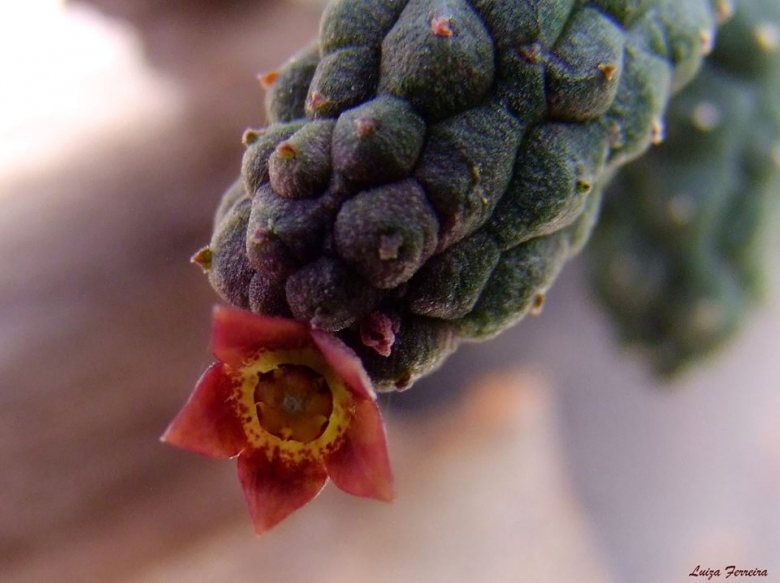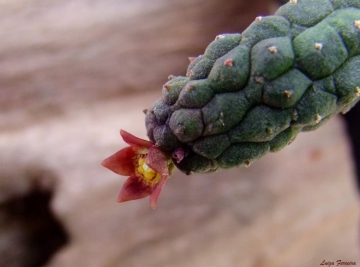
Echidnopsis dammanniana Photo by: Luiza Ferreira
Origin and Habitat: Echidnopsis dammannianaSN|30722]]SN|30722]] is found in North-Eastern Africa (Ethiopia, Somalia and Kenya).
Altitude range: Around 1000-2300 metres above sea level.
Synonyms:
See all synonyms of Echidnopsis dammanniana
back
Accepted name in llifle Database:Echidnopsis dammanniana SprengerCat. Dammann & Co. (1892) 4 fig. 5; Wien. Illustr. Gartenz. (1892) 351 fig. 59;Gartenfl. (1892) 526 fig. 107; N. E. Br. in Gard. Chron. (1894) ii. 530.Synonymy: 2
back
Description: Echidnopsis dammannianaSN|18992]]SN|30722]] is a low clumping perennial succulent that spread over the ground forming cushions. This species has sturdy stems like those of Echidnopsis cereiformisSN|18992]]SN|18992]], but up to 2 cm in diameter with characteristic, maroon-brown, speckled flowers somewhat flattened against the stem. E. dammanniana differs from Echidnopsis cereiformisSN|30722]]SN|18992]] by it shiny black-purple, sometimes speckled yellowish corona.
Stems: Procumbent, rigid, with clear latex, usually 5-15 (often up to 60) cm long, 12-20 mm thick, divided into 8-10 tessellate ribs, with tetragonal or hexagonal irregular mammillae, dull greyish to purplish-green or brownish, glabrous, finely papillose and faintly wrinkled.
Leaves: Rudimentary, short-lived, ascending, finely papillose, thick, triangular.
Flowers: Small, solitary or 2–5 together, subsessile, closely appressed to the stem, but the pedicels lengthening to 2 mm long in fruit. Calyx green, 5 lobed. Sepals 1.5 mm long, ovate-acuminate, glabrous, very minutely papillate. Corolla rotate, 7-11 mm across, dark purple-brown. purplish to greenish brown on the lobes, speckled with dull green-yellow, covered with minute, sharp-pointed papillae, with dark purple-brown dots on the disk. Tube very shallow. Lobes 5, curling when fading 2.5 mm long, 2 mm broad, ovate-triangular, acute, glabrous, outside green-brown, bristly-papillate. Corona five-lobed shiny black-purple, sometimes speckled brown or yellowish. Outer coronal-lobes small (c. 0.5 mm), spreading or deflexed, lanceolate, concave, channelled, ascending towards apices tooth-like or with the sides more or less pinched together at about the middle, dark purple-brown, glabrous. Inner coronal-lobes 1 mm long, broadly triangular, acute, incumbent on the backs of the anthers, dark purple-brown, glabrous. Pollinia yellow.
Bibliography: Major references and further lectures
1) N. E. Brown. “Flora of Tropical Africa”, Vol 4, 1904
2) James Cullen, Sabina G. Knees, H. Suzanne Cubey “The European Garden Flora Flowering Plants: A Manual for the Identification of Plants Cultivated in Europe, Both Out-of-Doors and Under Glass” Cambridge University Press, 11 August 2011
3) Focke Albers, Ulrich Meve “Illustrated Handbook of Succulent Plants: Asclepiadaceae: Asclepiadaceae” Volume 4 Springer Science & Business Media, 2002
4) Illustration: Bradleya 6: 12 (1988)
5) Illustration: Echidnopsis dammanniana Sprenger [as Echidnopsis somalensis N.E. Br.] [1332-368646-6600] Curtis’s Botanical Magazine, vol. 129 [ser. 3, vol. 59]: t. 7929 (1903) [M. Smith]
6) M. Gilbert, D. Goyder, J. Lavranos, S. Liede-Schumann, M. Thulin, and J. Venter . “Flora Somalia”, Vol 3, (2006) [updated by M. Thulin 2008]
 Echidnopsis dammanniana Photo by: Luiza Ferreira
Echidnopsis dammanniana Photo by: Luiza Ferreira Echidnopsis dammanniana Photo by: Luiza Ferreira
Echidnopsis dammanniana Photo by: Luiza FerreiraCultivation and Propagation: Echidnopsis dammannianaSN|30722]]SN|30722]] is an easy obliging blooming plant, which is happy in any average succulent house. This plant is easy to grow and flower, and one which will tolerate most soils and growing conditions.
Soil: Since roots are quite shallow, use a cactus mix or add extra perlite or pumice to regular soil potting soil. A gritty, very free-draining compost is suitable, and clay pots help the plants to dry out between watering.
Watering: They require moderately watering through the growing season but enjoy plenty of water and some fertiliser in hot weather, this helps them to flower freely. Water more sparingly in winter according to temperatures. But, as with most asclepiads, it is unwise to leave them wet in cold weather.
Hardiness: Winter care presents no problems at 5°C with plenty of light.
Sun Exposure: Partial sun or light shade.
Pest and diseases: They are generally fairly easy to grow, especially if kept pest-free. They are susceptible to stem and root mealy bugs, and damage from these may well initiate fungal attack. If you do have problems with a stem or with basal rotting, you can reliably isolate the healthy parts, dry them off, and re-root them in moist compost.
Cultural Practices: Re-pot every 2 years.
Propagation: Easiest with stem cuttings. Allow cuttings to dry a day before planting. Stems must be laid (Not buried) on gritty compost and will then root from the underside of the stems. It can also be increased from seeds sowing in spring in moist, sandy peat moss. Barely cover seeds.












